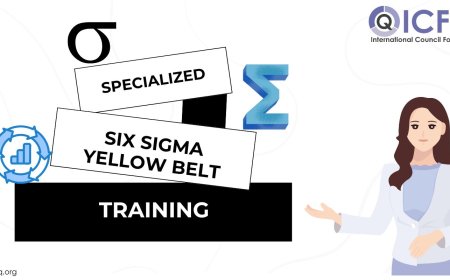Making things better in companies, the Six Sigma Green Belt is a big deal. It started way back in the 1980s at Motorola and has become popular since then. It's all about making things run smoother and better in businesses. Let's talk about why it's so important today. Six Sigma Green Belt is a way of working that uses data to find problems and fix them. It's like being a detective for making things work better. This method helps to find and get rid of mistakes in how things are done. It's not just for making things; it works in all kinds of businesses, from making stuff to providing services. When businesses use the Six Sigma Green Belt, they make customers happier and save money by doing things right the first time.
People in companies often take Six Sigma Green Belt courses to learn how to use it. These courses teach them how to find and fix problems using special tools and techniques. There are different levels of Six Sigma Green Belt, like Green Belt, Black Belt, Yellow Belt, and Master Black Belt. Each level teaches people more about how to use the Six Sigma Green Belt in different ways. Another important thing about the Six Sigma Green Belt is that it works well with Lean principles. When you put Lean and Six Sigma Green Belt together, you get even better results. This combo is called Lean Six Sigma, and it's great for making things more efficient and always improving.
Type of Six Sigma
When we talk about making things better and fixing problems in how we do things, one term that comes up a lot is "Six Sigma." It's all about finding ways to do things more efficiently and with fewer mistakes. But did you know there are different types of Six Sigma methods? Let's take a look at them!
1. Six Sigma Green Belt: People with this certification know a lot about Six Sigma and can use its ideas to help with their projects. They usually work closely with Black Belts.
2. Six Sigma Black Belt: These are the experts in Six Sigma. They lead big projects, help Green Belts learn, and make big changes in how things are done.
3. Six Sigma Yellow Belt: These folks have a basic understanding of Six Sigma. They usually help out on projects as part of a team.
4. Six Sigma Master Black Belt: These are the top dogs in Six Sigma. They're like the leaders of the leaders. They make big plans for Six Sigma in a company and help Black Belts learn and grow.
Other types of Six Sigma programs mix Six Sigma ideas with something called Lean methodology. This makes for even better ways to improve how things are done. Whether you learn Six Sigma in a classroom or online, it's all about giving you the power to make things better where you work. Choosing Six Sigma means always looking for ways to do things better.
Understanding Six Sigma and its different types isn't just about learning a method. It's about making a promise to always do things better and keep getting better at what we do.
1. Six Sigma Green Belt
The Six Sigma Green Belt is an important certification in quality management and process improvement. As part of the Six Sigma methodology, the Green Belt certification gives professionals the skills to lead projects and help improve their organizations. Six Sigma programs, especially Lean Six Sigma courses, focus on reducing defects and boosting efficiency.
Getting a Six Sigma Green Belt involves thorough training, often through accredited Six Sigma courses. These courses cover various techniques and the DMAIC (Define, Measure, Analyze, Improve, Control) methodology, which is essential for effective process improvement. Many people choose Six Sigma online courses for the flexibility they offer.
Online Six Sigma certification has become more popular, allowing access to high-quality training from anywhere. Whether you start with a Six Sigma Yellow Belt or aim for advanced levels like Six Sigma Black Belt or Master Black Belt, there’s a path for everyone. Six Sigma training enhances your skills in quality management, making you a valuable asset in any industry.
2. Six Sigma Black Belt
The Six Sigma Black Belt is a key role within the Six Sigma system, aimed at improving business processes by removing defects and ensuring quality. Those with this certification are experts in Six Sigma, knowing various techniques used for process improvement. To become a Six Sigma Black Belt, you typically start as a Six Sigma Yellow Belt, move to a Six Sigma Green Belt, and finally reach the Black Belt level. Each step involves completing specific courses and passing tough exams to show your skills.
Black Belts often lead Six Sigma projects, guiding teams through complex tasks and using advanced tools to improve efficiency. They play a crucial role in applying Six Sigma quality management and are skilled in methods like DMAIC (Define, Measure, Analyze, Improve, Control). Many training programs are available for those wanting to achieve this level, including traditional classes and Six Sigma online courses, which offer flexibility for busy schedules. Accredited institutions provide Six Sigma certification online, ensuring industry standards are met.
For further expertise, Lean Six Sigma courses combine Lean methods with Six Sigma for overall process optimization. The top level is the Six Sigma Master Black Belt, representing outstanding expertise and leadership in large projects. Getting Six Sigma certification boosts personal skills and significantly helps organizations by promoting a culture of continuous improvement and excellence.
3. Six Sigma Yellow Belt
Six Sigma Yellow Belt serves as an entry point into the Six Sigma world, offering beginners a solid grasp of its principles and techniques. It's perfect for those new to Six Sigma who wish to understand its core concepts and methods. Yellow Belt holders play a supportive role in Green Belt and Black Belt projects, aiding in quality management and process improvement. Six Sigma is all about minimizing variation and eliminating defects in processes to enhance efficiency and quality. You can learn about Six Sigma through various courses, including online and accredited ones, covering essentials like DMAIC (Define, Measure, Analyze, Improve, Control) and project tools.
Achieving a Six Sigma Yellow Belt opens doors to further certifications such as Green Belt, Black Belt, or even Master Black Belt, each level building upon the last to enhance leadership and project execution skills. For those seeking to incorporate Six Sigma into their careers, numerous training programs and Lean Six Sigma courses are available, with many offering online certification options for working professionals.Whether you're just starting your Six Sigma journey or aiming to advance, there's a range of programs tailored to meet your needs and help you excel in Six Sigma quality management.
4. Six Sigma Master Black Belt
Making things better at work and fixing problems, Six Sigma is like a really cool. And at the tippy-top of this team is the Six Sigma Master Black Belt. This person is super smart about Six Sigma stuff and helps teams fix tricky problems. They're not just good at doing Six Sigma themselves; they also teach other people how to be awesome at it, too.
To become a Six Sigma Master Black Belt, you have to go through a lot of training and learn all about Six Sigma. You learn things like how to make processes better, how to analyze data, and how to make sure things are good quality. After all that hard work, you get a special certificate saying you're really good at Six Sigma. Companies love having a Six Sigma Master Black Belt around because they make things work better. They help save money by fixing problems and making customers happier. Plus, they teach everyone else how to be better at their jobs, too.
Understanding the Role of DMAIC in Six Sigma
Six Sigma stands out as a powerful method to make processes better, aiming to reduce mistakes and make things more efficient. At the center of Six Sigma is DMAIC – Define, Measure, Analyze, Improve, and Control – an important way to get the results you want. Let’s look closely at DMAIC and why it's so important in the Six Sigma approach.
-
Define: It starts by clearly stating what the project aims to do, its scope, and what the people involved expect. This sets the path for what comes next.
-
Measure: Accuracy is key. This step involves collecting and analyzing data to understand exactly how the process works right now. Figuring out the most important things to measure helps make smart decisions.
-
Analyze: Here, we dig deep into the data to find out why things aren’t working well. This phase gives us important insights that help us know where to focus our efforts to improve.
-
Improve: With those insights, we can come up with and put into action solutions to fix the problems we found. Making things better happens through continual tweaking and making things more efficient.
-
Control: Making sure the improvements stick is crucial. This step sets up ways to keep an eye on things after changes are made to make sure they keep working well.
Importance of Six Sigma
Six Sigma is like a super tool that helps businesses do their work better. It's all about finding problems and fixing them to make things run smoother. Let's see why it's so important:
1. Making Things Better: Six Sigma helps find and fix mistakes, making products and services nicer. This makes customers happy and keeps them coming back.
2. Saving Money: By fixing mistakes early, Six Sigma helps save money that would be spent on redoing things. This means more profit for businesses.
3. Using Data Smartly: Six Sigma looks at numbers and facts to make decisions. This helps figure out why things go wrong and how to make them right.
4. Working Smarter: Six Sigma gives a roadmap (DMAIC) to make processes work better. This saves time and energy, making work more efficient.
5. Beating the Competition: Businesses using Six Sigma stand out by giving top-quality stuff and meeting customer needs better than others.
Six Sigma is a big deal for businesses today. It doesn't just make things better and cheaper, but it also helps build a culture where everyone wants to keep improving. And that's the secret to long-term success.
when we look closely at Six Sigma, we see how important it is for modern businesses. It's like a big deal for making things better in a company. Understanding what Six Sigma does helps us see how it can change the way a business works, making it better at what it does and more successful overall. When companies use Six Sigma methods, they can make their processes smoother, reduce mistakes, and make customers happier. Plus, it encourages everyone to keep finding ways to do things better, which is important in today's competitive world. So, basically, learning about Six Sigma isn't just helpful, it's necessary if a business wants to keep growing and doing well.










































